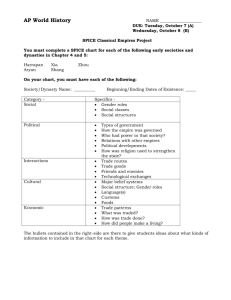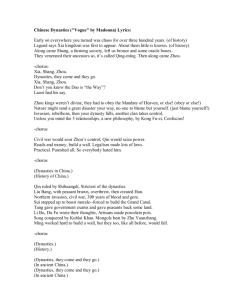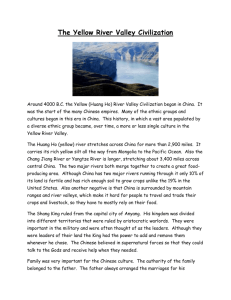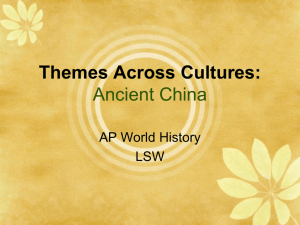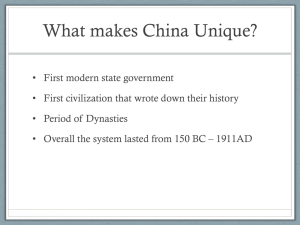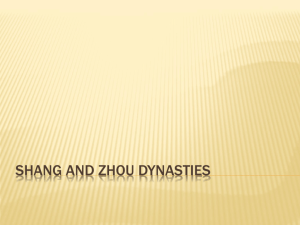The World's History, 3rd ed. Ch. 4: A Polycentric World
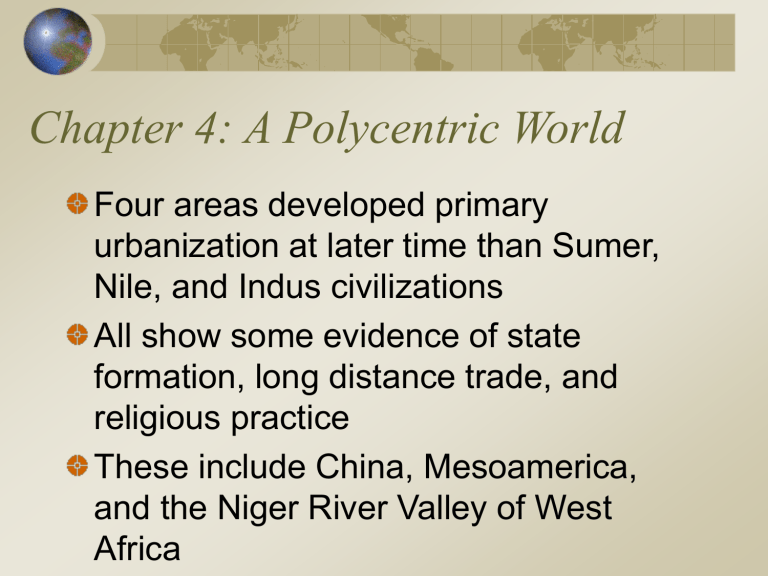
Chapter 4: A Polycentric World
Four areas developed primary urbanization at later time than Sumer,
Nile, and Indus civilizations
All show some evidence of state formation, long distance trade, and religious practice
These include China, Mesoamerica, and the Niger River Valley of West
Africa
The Xia, Shang, and Zhou
The Earliest Villages
Yangshao culture shows shift to neolithic patterns by 8000 B.C.E
Culture also produced oldest known playable musical instrument: the flute
Grew millet, rice, and wheat and domesticated animals including dogs, pigs, and goats
Yangshao lasted until 2700 B.C.E.
The Xia, Shang, and Zhou
The Earliest Villages (cont.)
Longshan culture comprised a more sophisticated neolithic people
Made pottery on wheels
Domesticated sheep and cattle
Separate branch of Longshan in
Shangdong
Evidence suggests a harsh world of fortified walls, decapitations, and bronze knives
The Xia, Shang, and Zhou
The Beginning of State Formation
Xia, Shang, and Zhou dynasties each dominated northeast China in chronological succession
Centered on the Huang He (Yellow River)
State formation may have begun under Xia
[2205-1766 B.C.E.] but evidence is sparse
Evidence of urbanization under Shang
[1766-1122 B.C.E.] is extensive
The Xia, Shang, and Zhou
The Beginnings of State Formation [cont.]
Zhou [1100-256 B.C.E.] consolidated city and state and left best archaeological remains and written records of the early dynasties
The three dynasties may have coexisted
Cities may have developed by time of Shang
Capital cities shifted frequently
Dynasties were wealthy and controlled large work gangs
The Xia, Shang, and Zhou
The Beginnings of State Formation
[cont.]
Sharp class distinctions included separate cemeteries for different levels of wealth
Chinese cities were also religious centers with kings presiding over rituals as well as administration and warfare
Human and animal sacrifice needed for religious ritual
The Xia, Shang, and Zhou
Early Evidence of Writing
Oracle bones were basis of early writing
Consisted of bones of birds and animals as well as turtle shells that were heated in fires
Cracks in heated bones were basis of predictions of the future or communications with the gods
The Xia, Shang, and Zhou
Historical Evidence of the Xia Dynasty
Has long been regarded as a mythical dynasty
Evidence of life at Erlitou matched myths
Xia ruled through clans; leader mediated between world of spirits and world of humans
Need to control Yellow River flooding required development of large labor gangs
Produced carved jade, bronze weapons, and pictograms [forerunners of written script]
The Xia, Shang, and Zhou
Similarities Among the Three Dynasties
All three developed similar walled cities and political structures
Literary evidence referring to different dynasties portrays similar values and practices
Dynasties became more hierarchical while reducing the power of women
The Xia, Shang, and Zhou
City and State Under Shang and Zhou
Shang ruler controlled network of cities from his capital city
Relatives controlled other cities, represented interests of king and shared local harvests
Shang ultimately controlled 40,000 square miles
Ongoing conflicts at edges of territory
The Xia, Shang, and Zhou
Early Royal Capitals
Shang capital city shifted frequently
Royal family and nobles lived within city wall which comprised palace/ritual center
Residents, craftsmen, and cemeteries were outside wall
Pattern of city included residences and cemeteries of wealthy located to the north, with poor living and buried to the south
The Xia, Shang, and Zhou
Anyang: The Last Shang Capital
Was last and most powerful center of
Shang
Area has been heavily farmed and looted, leaving few artifacts
Excellent bronzes were produced primarily for ritual purposes but bronze weapons enhanced power of Shang
The Xia, Shang, and Zhou
The Zhou Dynasty
Zhou reduced Shang to small warring power
Produced written records
Developed idea of “Mandate of Heaven” to justify power of king
Book of Songs a collection of ancient poetry
Transformed warfare to cavalry and infantry
End of Zhou known as era of Warring States
Mesoamerica and South America
Early cities were religious shrine centers linked by shamans to world of spirits
Cities built on lakes, not river systems
Work was more labor-intensive
No writing system except for Maya
These civilizations had foot in Stone
Age
Mesoamerica and South America
Origins: Migration and Agriculture
Humans entered the Americas 15,000 years ago
Developed maize by 5000 B.C.E. and beans and gourds by 3000 B.C.E.
Valley of Mexico and high Andes of Peru built on these developments to become centers of civilization
Mesoamerica and South America
Mesoamerican Urbanization: First Steps
Agricultural basis of urbanization present by 2000 B.C.E.
People had developed a wide range of irrigation techniques
• pot irrigation
• canal irrigation
• chinampas (hanging gardens)
Mesoamerica and South America
Olmec Civilization along the Gulf Coast
Emerged 1500 B.C.E on Gulf Coast of Mexico
San Lorenzo, oldest known site, ended 900
B.C.E.; produced unknown hieroglyphics, chinampas, and sculpture
La Venta lasted to 400 B.C.E.
Stone and jade was moved to La Venta from a great distance
Reason for Olmec’s decline unknown
Mesoamerica and South America
Zapotec Civilization in Oaxaca Valley
Olmec artifacts in Oaxaca by 1150 B.C.E.
Reached peak by 200 C.E.
Religious symbolism present in temples and pyramids
No central city but based on 2,000 terraces scattered across fifteen square miles
Mesoamerica and South America
The Urban Explosion: Teotihuacan
Represented true urban revolution
Peak was 550 C.E. with 100,000 residents
Strategic location in midst of Valley of
Mexico and mountain passes to the coast
Center of extensive trading network
City dominated by pyramid situated above ancient cave with religious significance
Mesoamerica and South America
The Urban Explosion: Teotihuacan
(cont.)
Cave and pyramid suggest belief that all life emerged from the “navel of the world”
Second pyramid and temple emphasize religious importance of Teotihuacan
Regular layout of city shows power of government
City burned down in 650 C.E. and civilization vanished within a hundred years
Mesoamerica and South America
Successor States in the Valley of
Mexico
Toltecs emerged in Valley by 900 C.E.
Toltecs honored Quetzalcoatl, god of
Teotihuacan
Aztecs entered valley after 1170 C.E.
• Developed civilization of 200,000
• Militaristic society
• Practiced human sacrifice
• Destroyed by invading Spanish with help of neighbors of Aztecs
Mesoamerica and South America
The Rise and Fall of the Maya
Maya incorporated Teotihuacan and Olmec ideas as well as their own
Located on the Yucatan peninsula
Classic phase (300-600 C.E.) included cities, monumental architecture, extensive sacrifices, and elaborate burials
Mesoamerica and South America
The Great City of Tikal
Religious and cultural center with political and economic role
Contained 360,000 people at its height
Developed calendar combining cosmic and historic events with agricultural cycle
Shaman-Kings bridged daily life and spirit world
Mesoamerica and South America
Maya Civilization in Decline
Classical period ended in 900 C.E.
Suspected reasons for decline include population pressure, climate change, warfare, pressure on resources
Some new Mayan towns emerged during decline at core
Few Mayan cities remained to greet
Spanish arrival
Mesoamerica and South America
Urbanization in South America
Few ties to Mesoamerican trends
Both regions built around religious shrines
Both areas developed empires: Aztec and
Incan
Main South American civilization in Andes mountains at 11,000 feet rather than arid
Pacific coast regions of present day
Ecuador, Peru, and Chile
Mesoamerica and South America
Coastal Settlements and Networks
Pacific coast was a source of fish and cotton
Labor brigades channeled river flow from
Andes into irrigated fields
Moche and Chimu were the major states of the coastal region
Mesoamerica and South America
Urbanization in the Andes Mountains
Trade networks connected mountains and coast
Chavin are first known Andean civilization
Tiwanaku irrigated high plains and established religious ritual and administrative practices that were preserved by successor states
• Huari
• Nazca
Mesoamerica and South America
The Inca
Combined Chimu (coastal), Chavin,
Tiwanaku, Huari and Nazca (Andes) cultures into single empire
Capital at Cuzco in Andes at 11,000 feet
Cusi Yupanqui established hereditary monarchy in 1438 using unpaid labor system (mit’a)
Had administrative system for conquered areas
Mesoamerica and South America
Agricultural Towns in North America
Few urban traits or nonagricultural economy
Towns in southwest influenced by Mexico
First fully developed towns comprised mound builders along Mississippi River at Cahokia
Mound towns had strong central authority
All North American towns were in decline before arrival of Europeans
The Niger River Valley
Until 1970s, all sub-Saharan towns were seen as derivatives of outside examples
Along east African coast, city development was influenced by outside traders
West African towns were regarded as response to Muslim trade contacts
New evidence challenges idea of lack of innovative urban centers in west Africa
The Niger River Valley
West Africa before Urbanization
Early developments include iron smelting
(possibly gained from the Phoenecians), terra cotta sculpture, and settled agriculture.
Region jumped from stone to iron ages with few examples of bronze artifacts
Bantu migrations carry knowledge of iron working and settled agriculture
The Niger River Valley
Jenne-jeno: A New Urban Pattern?
First known indigenous city in Sub-Sahara
City developed 400 C.E. and peaked 900
C.E.
Central area was a walled city containing eighty acres
Were probably ancestor worshippers
West African cities may have predated outside influences
In decline by 1100 C.E.
The Niger River Valley
State Formation?
Jenne-jeno may have been a collection of independent cities without central control
May have been a cooperative society with relative equality rather than organized by competition, dominance, and coercion
Alternate reasoning suggests Jenne-jeno may have developed only to level of
Olmecs in Mexico
First Cities: Make a Difference?
Important transition in human history
New scale and density of settlement
New technology in metallurgy
Monumental scale of architecture
Specialization and hierarchy in economy, politics, and society
Organized trade networks
Developed writing
Central religious role
